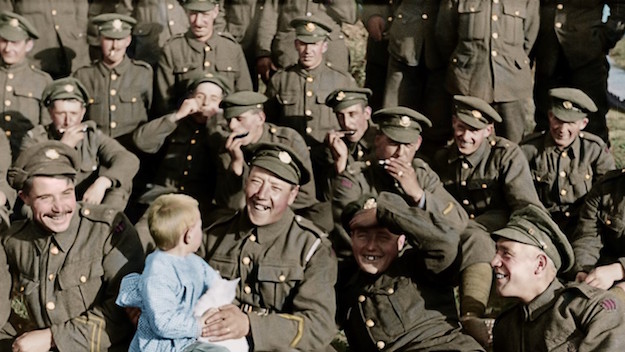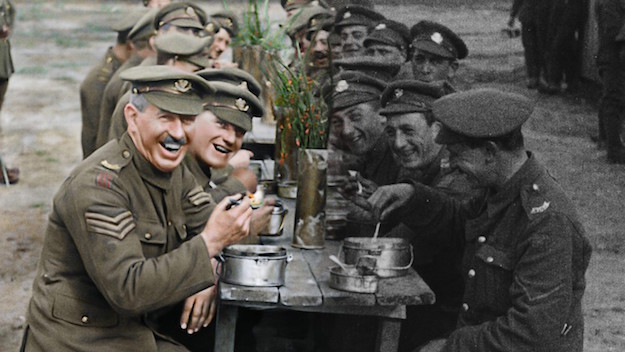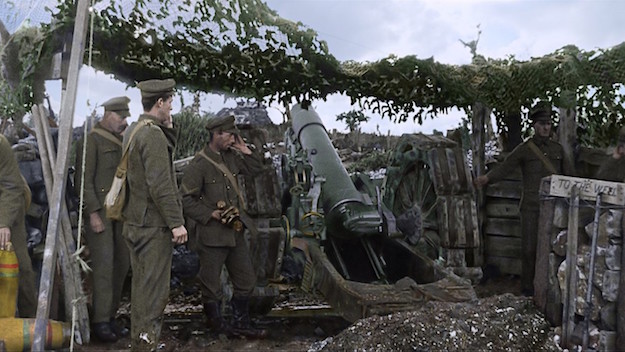Film of the Week: They Shall Not Grow Old
 Peter Jackson’s First World War documentary They Shall Not Grow Old is fascinating, and moving, because it looks into the past and unearths a spectacle of life and death; at the same time it’s horrifying, precisely because it presents life and death as spectacle. Commissioned by the commemorative project 14-18 NOW and the Imperial War Museum, in association with the BBC, Jackson’s film—dedicated among others, to his own grandfather, who served in the South Welsh Borderers—is on one level a sincere memorial in images and sound. On another, like all his work, it is first and foremost a special effects movie.
Peter Jackson’s First World War documentary They Shall Not Grow Old is fascinating, and moving, because it looks into the past and unearths a spectacle of life and death; at the same time it’s horrifying, precisely because it presents life and death as spectacle. Commissioned by the commemorative project 14-18 NOW and the Imperial War Museum, in association with the BBC, Jackson’s film—dedicated among others, to his own grandfather, who served in the South Welsh Borderers—is on one level a sincere memorial in images and sound. On another, like all his work, it is first and foremost a special effects movie.
The premise of the film (which had its world premiere this week at the London Film Festival) is that archive footage of the Great War has been specially processed—hand-colorized, digitized, converted into 3D, with voices and sound effects added. The effect is to make it seem as if events that took place a hundred years ago, and previously were captured in silent black and white, are actually taking place in front of us in a vivid timeless now. The project is a noble one, surely, and in keeping with that primordial aspect of image-making that André Bazin famously described as originating from “a mummy complex”: “The image helps us remember the subject and save him from a second spiritual death.”
The film’s title is a readjustment of a line from Laurence Binyon’s poem “For the Fallen”: it originally reads, “They shall grow not old, as we that are left grow old: / Age shall not weary them, nor the years contemn.” What’s at issue in the poem is the idea that the dead of the war will never be forgotten, and will always be remembered as people perpetually young, never destroyed by age. But in the context of a film that takes old images and “renews” them, the title comes, poignantly but more mundanely, to be a reminder that we’re looking at living people who were to all intents and purposes fated to die almost as soon as these images were taken. And more troublingly, the title suggests that these images make their subjects somehow death-proof, impervious to the wear and tear of mortality and time—and the chemical decay to which archive film images are traditionally subject.
But the uncomfortable feeling we get from watching Jackson’s film is not only that the images themselves have been preserved—embalmed, as it were, to extend Bazin’s mummy metaphor—but that so too have the people they represent. Watching the soldiers newly imbued with artificial life in this colorized imagery, it’s as we’re seeing not so much ghosts as the reanimated dead, restored to lifelike motion by the infusion of virtual blood into their skins and veins: digital image technology as a kind of ghoulish taxidermy.
There is plenty to commend Jackson’s film, which is essentially a lantern show of wonders, and for generations who have never read or heard much about the Great War it will be immensely informative. It serves as a reminder—and you surely can’t have too many—that history was experienced by living people, with feelings, physical bodies and voices. It also serves as a reminder, and again this is useful from time to time, that early 20th-century history did not take place in black and white.
The most impressive thing about the film is its use of voices: testimonies of over 100 British ex-servicemen of various backgrounds (the film almost exclusively concerns men, despite the end credits’ use of the ribald war ditty “Mademoiselle From Armentières”). Some are working-class, others clearly aristocratic, all culled from archives, cleaned up to pristine effect so that they sound as if they’re talking directly to interviewers, and to the audience, today. Herein lies the real wonder of the film, the clarity and directness—the presence, if you like—of the voices of people who are ghosts twice over. They themselves are long dead, recorded years ago; they are effectively the phantoms, speaking in old age, of the generation of youth seen on screen; and they are living ghosts, at least men on borrowed time, having unimaginably survived to tell the tale of events that should, by rights, have left them dead like their peers. Some, as we expect, tell tales of unimaginable horror and desolation; others, especially at the start when we hear how an unknowing generation insouciantly marched off to hell, are almost parodically deadpan expressions of the “phlegmatic” spirit traditionally attributed to the British: “It was just a job of work,” or “It was more like a great big game, apart from the killing and that sort of thing.” In a sequence in which soldiers recount how they became battle-hardened, killing becoming just a routine act, a posh voice calmly comments, “There was a little bit of slaughter going on.” At one telling moment, the sangfroid breaks, as a man tells of a terminally wounded man crying for Mummy. “I shot him—I had to,” he says—and his voice breaks. The voices come in a flood, one after another, relentlessly, an aural echo of shots of men marching, one after another in endless lines, across no-man’s-land. It’s in its sonic dimension that the film truly does, marvelously, become a séance, a conjuring of the speaking dead.

Visually, however, the film is questionable. There’s no shortage of revealing material. What’s shown is in turns harrowing, shocking, moving, at times even celebratory: the film finds life and even human joy among the horror. The squalor of trench life has been documented and reconstructed over and over again, in multiple art forms, but seeing the thing itself in its rawness is something you’re not prepared for—whether it’s the images of corpses sinking into the Somme mud, close-ups of gangrenous limbs affected by trench foot, or the utterly depressing latrine conditions, which of course many speakers, no doubt in the interest of sanity, manage to convert into blokeish comedy. There are also some images of a kind I’d never seen before: along with the familiar shots of endless plains of mud and barbed wire, images of soldiers with horse-drawn carts making their way up a tree-lined river in Northern France, an oasis of leafy calm amid the abyssal destruction. The bomb bursts were also a new image to me: as striking in their way as the more familiar nuclear mushroom clouds, but somehow primitive, earthy rather than airy, like monstrous huge potatoes bursting out of the sod.
But there’s something deeply strange about the film’s project, and the way it leads us into the world it reanimates. The film begins with black-and-white archive footage within a black frame: as the frame expands, the image fills the entire screen before fading. This is what we’re used to seeing, something from the past, this sequence tells us. Later on, the images suddenly explode into color, with the addition of sound, and it’s startling. We hear gunfire in the background, men barking orders, exchanging backchat. Lip-readers have studied the footage and we now know what people are saying: a man grins as he passes the camera and shouts, “Hello mum!” But does this strike us as living history, human experience seized from the grave—or just as a piquant novelty touch?
The color makes certain images indisputably tangible—never more so than in the image of a wounded man with a bare back, his pale flesh reminding us of these soldiers’ youth and fragility. One image, its chromatic authenticity no doubt scrupulously verified, is a real eye-opener: a haze of mustard gas filling the air with a sickly chartreuse miasma. But other touches seem inappropriate, the precision of their detail verging on kitsch, like the little dots of scarlet and blue of the poppies and other flowers seen in the foreground of a desolate expanse (poppies, of course, being anything but neutrally realistic in this context). And if we find the poppies discomforting, how do we feel about the blood meticulously limned into the images of the freshly slaughtered dead?
Jackson’s work with frame rate has attracted some criticism, but what’s troubling in general is the effect that his digital work has on his once-living subjects. In one sense, he doesn’t really make these images more alive, doesn’t give them substance, so much as flatten them: in some images, the 3-D has the effect of old-fashioned stereoscopic goggles, causing us to see a series of flattened planes, as if human figures have been cut out from card and pasted into the scene. In particular, the scrutiny of faces is very odd. We are, perhaps for the first time, conscious of seeing faces that are not distant forefathers, but people just like us: yes, some have irreducibly archaic physiognomies that immediately strike you as antique, possibly because of the prevalence of missing teeth. But a lot of faces do look as if they could be of our own time—especially poignant when they are faces are young.
Yet something strange happens to the faces, especially in sequences where Jackson enlarges details from larger images of groups: in trying to correct the ways in which the clarity of the image is eroded by the original grain, the technology introduces a new distortion. Sometimes the texture of the images swims as if in a heat haze, the faces themselves dancing and shimmering. And in their detail, the faces seem to have been restored as if by the meticulous imperfection of the mortician’s art: eyes sometimes seem to melt into cheeks, features seem to have been pasted onto the soldiers’ heads, some people look as if they’re wearing stocking masks to preserve their anonymity. In the strange swimminess of the textures—whether or not Jackson uses slow motion, as he does in some sequences—the characters seem to be suspended in jelly-like air, as if their actions too are embalmed: they become like hologram ghosts, summoned from the past to repeat their former actions endlessly, repeatedly. Yes, we know that old film invariably does this to long-vanished people, yet the specific textures at work here make us aware of this in an usually unsettling, somehow improper-seeming way.

To use the word “improper” implies an ethical statement about uses of archive footage, war imagery especially—and sometimes, yes, our sense of impropriety is just to do with a feeling of the uncanny, a sense that something’s a little off, creepy, not quite right. But there are questions to be asked here about the presumptuousness of contemporary technology in its claims to bring the past alive “as never before.” This film’s 3-D imagery certainly allows us to feel immersed in World War One in a perhaps unprecedented way: but should we feel immersed, or should new generations be encouraged, rather, to contemplate past horror from a distance, to use their imagination to understand suffering, rather than being allowed to experience it vicariously? And how would we feel about these techniques—3-D, colorization, the showmanly bringing-to-life—if applied to, say, footage of the camps?
There’s another issue regarding the “freshness” of the imagery and its effect of possibly diminishing the original, even of showing contempt for the archive material, as Pamela Hutchinson has argued. There is much to be said for cleaning historic monuments, and counter-arguments too for leaving them as transformed by the ravages of time. This film, in its eagerness for freshening, reminds us that the moss on a gravestone can itself be part of the memorial, the visible mark of time that is inseparable from the work of memory.
The one aspect of this film in which the cleaning work, the absence of crackle, distortion, and flattening distance, really produces something irreducibly vivid is in those voices, perhaps because of the simplicity and purity, because of the fact that we’re not so aware of an embellishing process at work. The voices speak for themselves, whereas the images (as CGI images almost invariably do) make us want to ask how it was done. The voices asks us to remember, and to imagine: to partake in the ceremony of remembering, as it were, rather than marveling from ringside seats. A radio-only version of this film would be something indeed.
Jonathan Romney is a contributing editor to Film Comment and writes its Film of the Week column. He is a member of the London Film Critics Circle.







